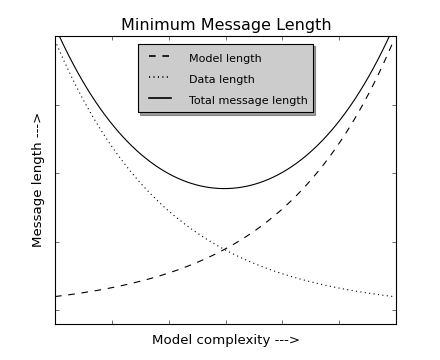

(Source code, png, hires.png, pdf)

import numpy as np
import matplotlib.pyplot as plt
a = np.arange(0,3,.02)
b = np.arange(0,3,.02)
c = np.exp(a)
d = c[::-1]
fig = plt.figure()
ax = fig.add_subplot(111)
ax.plot(a,c,'k--',a,d,'k:',a,c+d,'k')
leg = ax.legend(('Model length', 'Data length', 'Total message length'),
'upper center', shadow=True)
ax.set_ylim([-1,20])
ax.grid(False)
ax.set_xlabel('Model complexity --->')
ax.set_ylabel('Message length --->')
ax.set_title('Minimum Message Length')
ax.set_yticklabels([])
ax.set_xticklabels([])
# set some legend properties. All the code below is optional. The
# defaults are usually sensible but if you need more control, this
# shows you how
# the matplotlib.patches.Rectangle instance surrounding the legend
frame = leg.get_frame()
frame.set_facecolor('0.80') # set the frame face color to light gray
# matplotlib.text.Text instances
for t in leg.get_texts():
t.set_fontsize('small') # the legend text fontsize
# matplotlib.lines.Line2D instances
for l in leg.get_lines():
l.set_linewidth(1.5) # the legend line width
plt.show()
Keywords: python, matplotlib, pylab, example, codex (see Search examples)